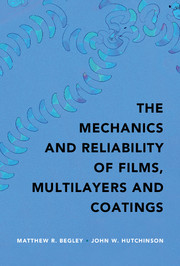Book contents
- Frontmatter
- Contents
- Acknowledgements
- Notation
- 1 Introduction
- 2 Key Mechanics Concepts
- 3 Linear Elastic Fracture Mechanics
- 4 Steady-State Delamination of Bilayers
- 5 Steady-State Delamination in Multilayers
- 6 Steady-State Channeling and Tunneling Cracks
- 7 Crack Kinking from an Interface
- 8 Crack Penetration, Deflection or Arrest?
- 9 Edge and Corner Interface Cracks
- 10 Buckling Delamination
- 11 Delamination of Thin Strips (Patterned Lines)
- 12 Delamination in Multilayers Subject to Steady-State Temperatures
- 13 Cracking under Transient Temperature Distributions
- 14 Software for Semi-Infinite Multilayers: Steady-State Delamination
- 15 Software for Semi-Infinite Multilayers: Transient Delamination
- 16 Finite Element Software for Multilayers: LayerSlayer FEA
- 17 Convergence and Benchmarks with LayerSlayer FEA
- Appendix Asymptotic Crack Tip Displacement Fields for an Interface Crack
- References
- Index
1 - Introduction
Published online by Cambridge University Press: 13 July 2017
- Frontmatter
- Contents
- Acknowledgements
- Notation
- 1 Introduction
- 2 Key Mechanics Concepts
- 3 Linear Elastic Fracture Mechanics
- 4 Steady-State Delamination of Bilayers
- 5 Steady-State Delamination in Multilayers
- 6 Steady-State Channeling and Tunneling Cracks
- 7 Crack Kinking from an Interface
- 8 Crack Penetration, Deflection or Arrest?
- 9 Edge and Corner Interface Cracks
- 10 Buckling Delamination
- 11 Delamination of Thin Strips (Patterned Lines)
- 12 Delamination in Multilayers Subject to Steady-State Temperatures
- 13 Cracking under Transient Temperature Distributions
- 14 Software for Semi-Infinite Multilayers: Steady-State Delamination
- 15 Software for Semi-Infinite Multilayers: Transient Delamination
- 16 Finite Element Software for Multilayers: LayerSlayer FEA
- 17 Convergence and Benchmarks with LayerSlayer FEA
- Appendix Asymptotic Crack Tip Displacement Fields for an Interface Crack
- References
- Index
Summary
A ‘generic’ system consisting of bonded layers of different materials and illustrations of various failure modes are shown in Figure 1.1. Arguably, the two dominant technological applications with this type of geometry are microelectronic devices and protective coatings in extreme environments (e.g., thermal barrier coatings). These applications involve layers with very disparate properties and are subjected to rather aggressive external stimuli. Cracking happens either between the layers (interface delamination or debonding) or within a layer (tunneling or channeling cracks). Delamination can occur regardless of whether the stresses are tensile or compressive, while buckling-driven delamination occurs only in layers experiencing compressive stress, and channeling or tunneling cracks require tensile stress in the layers.
Failure can be driven by a variety of factors, but it is probably fair to state that the integrity of the vast majority of multilayered devices is controlled by the layers’ tendency to expand at different rates in response to thermal, mechanical or chemical stimuli. In essence, when left by their lonesome, the layers expand differently in response to temperature fields, mechanical loading and so forth. However, in the multilayer component they are not alone: they are constrained to experience conformal deformation where they are bonded. This constraint generates stresses (both tensile and compressive) and stored elastic energy that drive system failure. Crudely speaking, the layers would be happiest and in their lowest energy state as separate pieces, and they seek to return there – even if it means splitting themselves into pieces and leaving part of themselves stuck to another layer.
As with the development of any predictive framework, the initial challenge is to reduce the complexity of the actual system to produce a model that captures the salient features of the system, while ignoring those details that have little effect on the behavior of interest. This can be a critical step in the development of multilayered systems, because their geometrical and multimaterial complexity can make full numerical representations extremely costly. Make no mistake: this is an art.1 Further, it can be highly problem specific. Nonetheless, there are some central idealizations that are widely applied to thin film systems that have served to generate considerable general insight regarding failure.
- Type
- Chapter
- Information
- Publisher: Cambridge University PressPrint publication year: 2017



